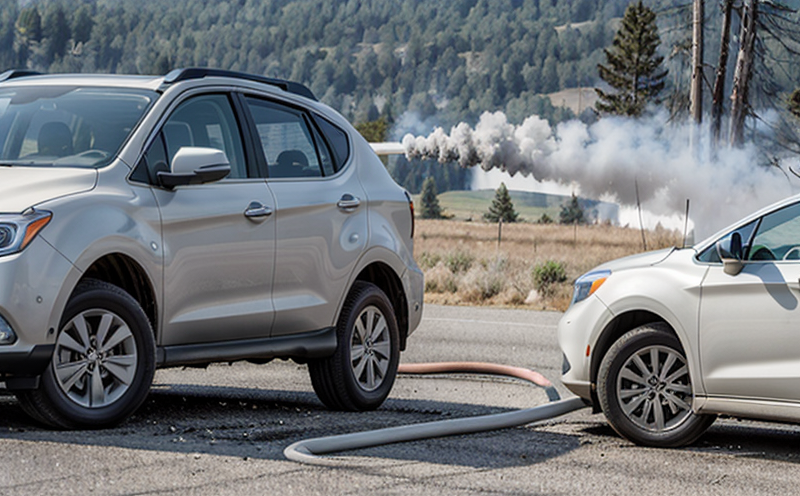Smoke Density Testing of Insulation Materials
In fire safety testing, smoke density is a critical parameter that assesses how much smoke an insulation material produces when subjected to heat and flame. This test is essential in ensuring the material's performance under fire conditions, particularly for its impact on visibility and respiratory health within enclosed spaces like buildings.
The test involves measuring the amount of light absorbed by the smoke produced from a burning specimen. The apparatus used typically includes a radiant heat source, a combustion chamber, and a photometer to measure transmitted light. Specimens are prepared according to relevant standards such as ISO 5660-1:2014 or ASTM E907:2018.
The procedure begins by igniting the specimen under controlled conditions in the combustion chamber. The smoke produced is then passed through a photometer, which measures the light absorption based on the amount of transmitted light. This measurement provides an indication of the density of the smoke generated. The results are typically expressed as a percentage or optical density.
The test aims to determine whether the insulation material meets fire safety regulations and industry standards for smoke production. For instance, ISO 5660-1:2014 specifies the method for determining smoke parameters in materials used in building construction. This standard is crucial because it ensures that the material does not impair visibility or cause respiratory distress during a fire.
Understanding smoke density testing requires knowledge of the equipment and techniques involved, as well as an appreciation of its significance in fire safety. The test helps identify potential hazards associated with specific materials and aids in selecting safer alternatives for use in construction and other applications where fire resistance is paramount.
In summary, smoke density testing plays a vital role in evaluating the performance of insulation materials under fire conditions. By measuring how much light is absorbed by the smoke produced, this test provides valuable insights into the material's ability to protect occupants during emergencies. Compliance with relevant standards ensures that these materials meet essential safety requirements, contributing significantly to overall fire safety.
Applied Standards
The primary standard used in smoke density testing of insulation materials is ISO 5660-1:2014, which provides the method for determining smoke parameters in materials used in building construction. This international standard ensures that tests are conducted under consistent and controlled conditions, providing reliable data for evaluating fire performance.
Other relevant standards include ASTM E907:2018, which specifies the test methods for measuring smoke density from small-scale burning of materials. These standards ensure consistency in testing procedures, making it easier to compare results across different laboratories and regions.
| Standard | Description |
|---|---|
| ISO 5660-1:2014 | Determines smoke parameters in materials used in building construction. |
| ASTM E907:2018 | Measures smoke density from small-scale burning of materials. |
The application of these standards ensures that the testing process is rigorous and reproducible, leading to accurate assessments of the material's fire safety properties. Compliance with such standards is crucial for ensuring product quality and meeting regulatory requirements in various industries.
Benefits
Smoke density testing offers numerous benefits that are essential for maintaining high standards of fire safety. One significant advantage is enhanced occupant protection, as the test helps identify materials that may produce excessive smoke during a fire event. By selecting materials with lower smoke densities, buildings can maintain better visibility and reduce respiratory risks for occupants.
This testing also contributes to improved regulatory compliance by ensuring that insulation materials meet specified standards such as ISO 5660-1:2014 and ASTM E907:2018. Compliance with these regulations not only helps avoid legal penalties but also enhances the reputation of the manufacturer or supplier.
Another benefit is cost savings in the long term, as testing early in the product development process can identify potential issues before they become significant problems. This allows for timely adjustments to the design and materials used, reducing rework and minimizing waste.
In addition, smoke density testing facilitates better decision-making by providing clear data on material performance. This information helps stakeholders make informed choices about which insulation materials are most suitable for specific applications, leading to safer environments overall.
Overall, smoke density testing is a crucial step in ensuring the fire safety of buildings and other structures that use insulation materials. It promotes better protection for occupants, ensures compliance with regulations, saves costs through early problem identification, and supports more informed decision-making processes.
Industry Applications
Smoke density testing has wide-ranging applications across various industries where fire safety is of paramount importance. One key application is in the construction sector, particularly for buildings that require high levels of fire resistance. Insulation materials used in such structures must meet stringent standards to ensure they do not compromise occupant safety during a fire.
| Industry | Application |
|---|---|
| Construction | Evaluates insulation materials used in high-rise buildings for fire resistance. |
| Automotive | Analyzes seat coverings and other interior materials to ensure they do not release harmful fumes or gases during a fire. |
| Aerospace | Tests insulation used in aircraft interiors to prevent the spread of smoke and toxic gases. |
| Military | Evaluates materials for use in military vehicles and structures to ensure they meet fire safety standards. |
In the automotive industry, for example, smoke density testing is crucial for seat coverings and other interior materials. These tests help ensure that these components do not release harmful fumes or gases during a fire event. In aerospace applications, similar considerations apply to insulation used in aircraft interiors, where preventing the spread of smoke and toxic gases is critical.
The military sector also places emphasis on fire safety, especially for vehicles and structures used by personnel. By ensuring that insulation materials meet rigorous standards, the military can enhance safety during emergencies and improve overall operational effectiveness.





